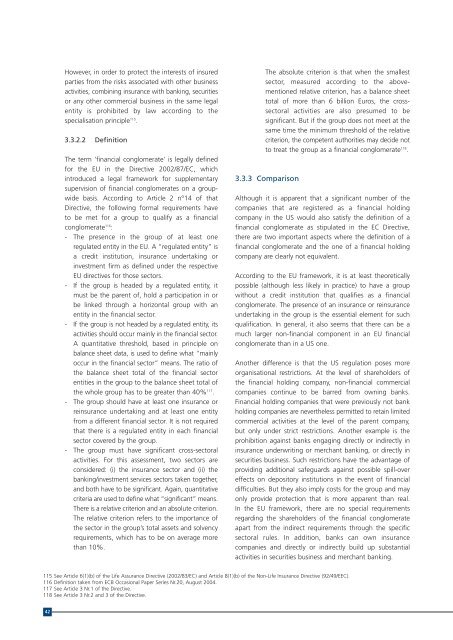A comparative analysis of the US and EU retail banking markets - Wsbi
A comparative analysis of the US and EU retail banking markets - Wsbi
A comparative analysis of the US and EU retail banking markets - Wsbi
Create successful ePaper yourself
Turn your PDF publications into a flip-book with our unique Google optimized e-Paper software.
However, in order to protect <strong>the</strong> interests <strong>of</strong> insured<br />
parties from <strong>the</strong> risks associated with o<strong>the</strong>r business<br />
activities, combining insurance with <strong>banking</strong>, securities<br />
or any o<strong>the</strong>r commercial business in <strong>the</strong> same legal<br />
entity is prohibited by law according to <strong>the</strong><br />
specialisation principle 115 .<br />
3.3.2.2 Definition<br />
The term ‘financial conglomerate’ is legally defined<br />
for <strong>the</strong> <strong>EU</strong> in <strong>the</strong> Directive 2002/87/EC, which<br />
introduced a legal framework for supplementary<br />
supervision <strong>of</strong> financial conglomerates on a groupwide<br />
basis. According to Article 2 n°14 <strong>of</strong> that<br />
Directive, <strong>the</strong> following formal requirements have<br />
to be met for a group to qualify as a financial<br />
conglomerate 116 :<br />
- The presence in <strong>the</strong> group <strong>of</strong> at least one<br />
regulated entity in <strong>the</strong> <strong>EU</strong>. A “regulated entity” is<br />
a credit institution, insurance undertaking or<br />
investment firm as defined under <strong>the</strong> respective<br />
<strong>EU</strong> directives for those sectors.<br />
- If <strong>the</strong> group is headed by a regulated entity, it<br />
must be <strong>the</strong> parent <strong>of</strong>, hold a participation in or<br />
be linked through a horizontal group with an<br />
entity in <strong>the</strong> financial sector.<br />
- If <strong>the</strong> group is not headed by a regulated entity, its<br />
activities should occur mainly in <strong>the</strong> financial sector.<br />
A quantitative threshold, based in principle on<br />
balance sheet data, is used to define what “mainly<br />
occur in <strong>the</strong> financial sector” means. The ratio <strong>of</strong><br />
<strong>the</strong> balance sheet total <strong>of</strong> <strong>the</strong> financial sector<br />
entities in <strong>the</strong> group to <strong>the</strong> balance sheet total <strong>of</strong><br />
<strong>the</strong> whole group has to be greater than 40% 117 .<br />
- The group should have at least one insurance or<br />
reinsurance undertaking <strong>and</strong> at least one entity<br />
from a different financial sector. It is not required<br />
that <strong>the</strong>re is a regulated entity in each financial<br />
sector covered by <strong>the</strong> group.<br />
- The group must have significant cross-sectoral<br />
activities. For this assessment, two sectors are<br />
considered: (i) <strong>the</strong> insurance sector <strong>and</strong> (ii) <strong>the</strong><br />
<strong>banking</strong>/investment services sectors taken toge<strong>the</strong>r,<br />
<strong>and</strong> both have to be significant. Again, quantitative<br />
criteria are used to define what “significant” means.<br />
There is a relative criterion <strong>and</strong> an absolute criterion.<br />
The relative criterion refers to <strong>the</strong> importance <strong>of</strong><br />
<strong>the</strong> sector in <strong>the</strong> group’s total assets <strong>and</strong> solvency<br />
requirements, which has to be on average more<br />
than 10%.<br />
The absolute criterion is that when <strong>the</strong> smallest<br />
sector, measured according to <strong>the</strong> abovementioned<br />
relative criterion, has a balance sheet<br />
total <strong>of</strong> more than 6 billion Euros, <strong>the</strong> crosssectoral<br />
activities are also presumed to be<br />
significant. But if <strong>the</strong> group does not meet at <strong>the</strong><br />
same time <strong>the</strong> minimum threshold <strong>of</strong> <strong>the</strong> relative<br />
criterion, <strong>the</strong> competent authorities may decide not<br />
to treat <strong>the</strong> group as a financial conglomerate 118 .<br />
3.3.3 Comparison<br />
Although it is apparent that a significant number <strong>of</strong> <strong>the</strong><br />
companies that are registered as a financial holding<br />
company in <strong>the</strong> <strong>US</strong> would also satisfy <strong>the</strong> definition <strong>of</strong> a<br />
financial conglomerate as stipulated in <strong>the</strong> EC Directive,<br />
<strong>the</strong>re are two important aspects where <strong>the</strong> definition <strong>of</strong> a<br />
financial conglomerate <strong>and</strong> <strong>the</strong> one <strong>of</strong> a financial holding<br />
company are clearly not equivalent.<br />
According to <strong>the</strong> <strong>EU</strong> framework, it is at least <strong>the</strong>oretically<br />
possible (although less likely in practice) to have a group<br />
without a credit institution that qualifies as a financial<br />
conglomerate. The presence <strong>of</strong> an insurance or reinsurance<br />
undertaking in <strong>the</strong> group is <strong>the</strong> essential element for such<br />
qualification. In general, it also seems that <strong>the</strong>re can be a<br />
much larger non-financial component in an <strong>EU</strong> financial<br />
conglomerate than in a <strong>US</strong> one.<br />
Ano<strong>the</strong>r difference is that <strong>the</strong> <strong>US</strong> regulation poses more<br />
organisational restrictions. At <strong>the</strong> level <strong>of</strong> shareholders <strong>of</strong><br />
<strong>the</strong> financial holding company, non-financial commercial<br />
companies continue to be barred from owning banks.<br />
Financial holding companies that were previously not bank<br />
holding companies are never<strong>the</strong>less permitted to retain limited<br />
commercial activities at <strong>the</strong> level <strong>of</strong> <strong>the</strong> parent company,<br />
but only under strict restrictions. Ano<strong>the</strong>r example is <strong>the</strong><br />
prohibition against banks engaging directly or indirectly in<br />
insurance underwriting or merchant <strong>banking</strong>, or directly in<br />
securities business. Such restrictions have <strong>the</strong> advantage <strong>of</strong><br />
providing additional safeguards against possible spill-over<br />
effects on depository institutions in <strong>the</strong> event <strong>of</strong> financial<br />
difficulties. But <strong>the</strong>y also imply costs for <strong>the</strong> group <strong>and</strong> may<br />
only provide protection that is more apparent than real.<br />
In <strong>the</strong> <strong>EU</strong> framework, <strong>the</strong>re are no special requirements<br />
regarding <strong>the</strong> shareholders <strong>of</strong> <strong>the</strong> financial conglomerate<br />
apart from <strong>the</strong> indirect requirements through <strong>the</strong> specific<br />
sectoral rules. In addition, banks can own insurance<br />
companies <strong>and</strong> directly or indirectly build up substantial<br />
activities in securities business <strong>and</strong> merchant <strong>banking</strong>.<br />
115 See Article 6(1)(b) <strong>of</strong> <strong>the</strong> Life Assurance Directive (2002/83/EC) <strong>and</strong> Article 8(1)(b) <strong>of</strong> <strong>the</strong> Non-Life Insurance Directive (92/49/EEC).<br />
116 Definition taken from ECB Occasional Paper Series Nr.20, August 2004.<br />
117 See Article 3 Nr.1 <strong>of</strong> <strong>the</strong> Directive.<br />
118 See Article 3 Nr.2 <strong>and</strong> 3 <strong>of</strong> <strong>the</strong> Directive.<br />
42
















